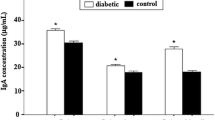Abstract
Objectives
Blood and saliva samples were obtained to examine if there is a correlation between saliva glycated protein and blood glycated protein.
Methods
Blood and saliva samples of 51 male workers were collected. The fructosamine and hydrazine methods were used to measure saliva glycated protein. HbA1c, fructosamine and blood glucose were measured as indices of blood glycated protein, and the correlation between blood glycated protein and saliva glycated protein was examined.
Results
Saliva fructosamine glycated protein showed a significant correlation with HbA1c and blood glucose (r=0.449; p=0.001 and r=0.445; p=0.001, respectively). No correlation was identified between saliva hydrazine glycated protein and the index of blood glycated protein.
Conclusions
Blood glycated protein and blood glucose could be estimated by measuring saliva glycated protein.
Similar content being viewed by others
References
Maillard LC. Action des acides amines sur les sucres; formation des melanoidines par voie methodique. C. R. Acad. Sci. Gen. 1912; 154: 66.
Little RR, Wiedmeyer HM, England JD, Rohlfing CL, Madsen RW, Goldstein DE, et al. International standardization of glycohemoglobin measurements: practical application. Clin. Chem. 1993; 39: 2356.
Goldstein DE, Little RR, Lorenz RA, Malone JI, Nathan D, Peterson CM. Tests of glycemia in diabetes. Diabetes Care 1995; 18: 896–909.
Shima K, Ito N, Abe F, Hirota M, Yano M, Yamamoto Y, et al. High-performance liquid chromatographic assay of serum glycated albumin. Diabetologia 1988; 31: 627–631.
Oimomi M, Maeda Y, Hata F, Kitamura Y, Matsumoto S, Hatanaka H, et al. Increased fructose-lysine of hair protein and blood glucose control in diabetic patients. Horm. Metab. Res. 1988; 20: 654–655.
Kobayashi K, Igimi H. Glycation index of hair for noninvasive estimation of diabetic control. Biol. Pharm. Bull. 1996; 19: 487–490.
Bakan E, Bakan N. Glycosylation of nail in diabetics: possible marker of long-term hyperglycemia. Clin. Chim. Acta 1985; 147: 1–5.
Delbridge L, Ellis CS, Robertson K, Lequesne LP. Nonenzymatic glycosylation of keratin from the stratum corneum of the diabetic foot. Br. J. Dermatol. 1985; 112: 547–554.
Li YM. Glycation ligand binding motif in lactoferrin. Implications in diabetic infection. Adv. Exp. Med. Biol. 1998; 443: 57–63.
Dodds MW, Yeh CK, Johnson DA. Salivary alterations in type 2 (non-insulin-dependent) diabetes mellitus and hypertension. Community Dent. Oral Epidemiol. 2000; 28: 373–381.
Belce A, Uslu E, Kucur M, Umut M, Ipbuker A, Seymen HO. Evaluation of salivary sialic acid level and Cu−Zn superoxide dismutase activity in type 1 diabetes mellitus. Tohoku J. Exp. Med. 2000; 192: 219–225.
Kobayashi K, Yoshimoto K, Hirauchi K, Uchida K. Determination of glycated proteins in biological samples based on colorimetry of 2-keto-glucose released with hydrazine. Biol. Pharm. Bull. 1994; 17: 365–369.
Morimoto K. Lifestyle and health. Japanese Journal of Hygine 2000; 54: 572–591.
Hagihara A, Morimoto K. Personal health practices and attitudes toward nonsmokers’ legal rights in Japan. Soc. Sci. Med. 1991; 33: 717–721.
Morimoto K. Stress-kiki no yobo-igaku (in Japanese). Tokyo: NHK books; 1997.
Bradford MM. A rapid and sensitive method for the quantitation of microgram quantities of protein utilizing the principle of protein-dye binding. Anat. Biochem. 1976; 72: 248–254.
SPSS Inc. SPSS Base 10.0 Brief Guide. Chicago: SPSS Inc.: 2000.
Kjellman O. The presence of glucose in gingival exudate and resting saliva of subjects with insulin-treated diabetes mellitus. Sven. Tandlak. Tidskr. 1970; 63: 11–19.
Shannon TL. Blood and saliva glucose levels in relation to gingival health. J. Indian Dent. Assoc. 1973; 45: 299–302.
Forbat LN, Collins RE, Maskell GK, Sonksen PH. Glucose concentrations in parotid fluid and venous blood of patients attending a diabetic clinic. J. R. Soc. Med. 1981; 74: 725–728.
Sandham HJ, Kleinberg I. Utilization of glucose and lactic acid by salivary sediment. Arch. Oral Biol. 1969; 14: 597–602.
Yamaguchi M, Kimura H, Kano Y, Egusa G, Kita J. Individual correlation of blood glucose and saliva glucose. J. Japan Diab. Soc. 1997; 40: 335–340.
Author information
Authors and Affiliations
Corresponding author
Rights and permissions
About this article
Cite this article
Nakamoto, I., Morimoto, K., Takeshita, T. et al. Correlation between saliva glycated and blood glycated proteins. Environ Health Prev Med 8, 95–99 (2003). https://doi.org/10.1007/BF02897922
Received:
Accepted:
Issue Date:
DOI: https://doi.org/10.1007/BF02897922




